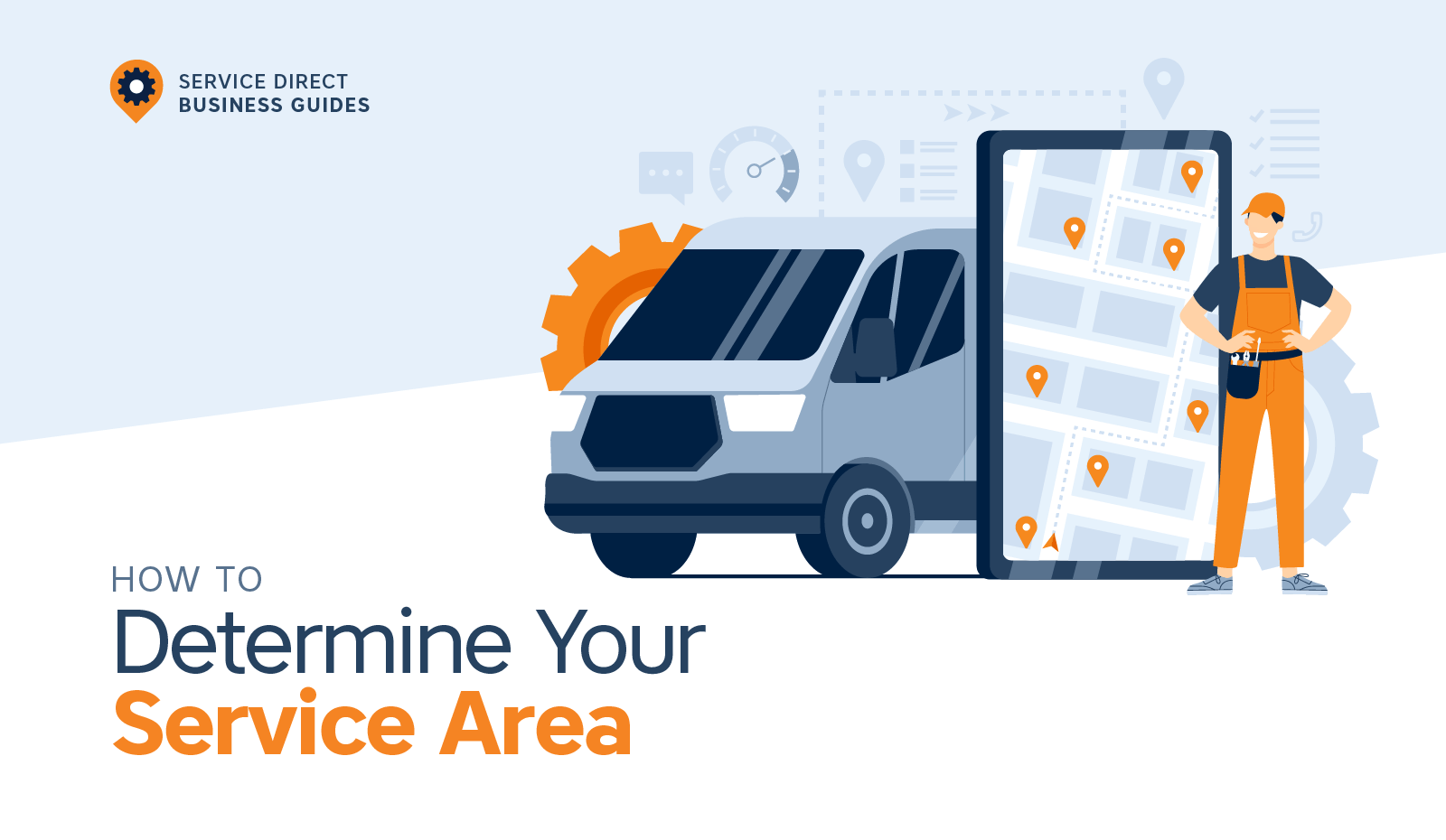How to Determine Your Service Area
When starting a service-based business, one of the key decisions you'll need to make is determining your service area. This choice will have a significant impact on your business's success and growth.
Because your service area is the established geographic location that you provide services within, it’s crucial to have a distinguished area that is the right size for your capacity.
Finding the right balance between geographic reach and operational efficiency is crucial. In this blog post, we will guide you through the considerations for determining your service area, specifically tailored for first-time business owners with limited business expertise.
Why Do I Need a Service Area?
A pre-determined service area is essential for small service-based businesses for a few reasons.
Firstly, defining a service area provides clarity and focus.
By narrowing down your geographic reach, you can concentrate your marketing efforts and resources on specific locations. This allows you to target your ideal customers more effectively, understanding their needs and preferences.
With a well-defined service area, you can tailor your business strategies to resonate with the local audience, increasing the chances of attracting and retaining customers.
Secondly, having a pre-determined service area enables better operational efficiency.
As a small business, optimizing your resources and managing costs is particularly crucial for success. By limiting your service area, you can minimize travel time and expenses associated with reaching customers, which allows you to provide more responsive and cost-effective services.
With a smaller service area, you can also better manage your staffing needs, ensuring you have the right number of trained professionals available to meet customer demand. Operational efficiency leads to higher customer satisfaction, improved service quality, and ultimately, a stronger reputation for your business.
Now let’s look at the key steps you should take when determining your service area.
Start With Market Research
Before setting up your service area, it's essential to conduct thorough market research. Understanding your target audience, their needs, and preferences will help you make informed decisions.

Consider the following elements when conducting market research:
- Demographics: Identify the characteristics of your ideal customers, such as age, income level, and lifestyle. This will help you pinpoint areas with a higher concentration of potential clients and ensure your marketing strategies and other business plans align with the customers in your service area.
- Competition Analysis: Assess the competitive landscape in different locations. Determine the saturation of similar businesses to yours and evaluate their service quality and pricing. This analysis will help you identify gaps and opportunities in various areas as well as avoid settling on an oversaturated service area.
- Demand Assessment: Evaluate the demand for your services in different locations. Look for areas with high population density, growing economies, or underserved markets to ensure you have room to grow your business through word of mouth and other localized advertising efforts.
Adequately researching the market before determining your service area will help ensure you don’t put your valuable time and resources into a market that is not primed to convert.
AI-Assisted Market Research
In 2025, leveraging artificial intelligence to support your business is crucial. To build a truly profitable and efficient business, you need to go deeper. That's why 77% of small businesses are using AI daily.

Traditional market research helps give you a snapshot; AI gives you an enhanced model of your potential market. By leveraging AI, you can make data-driven decisions that minimize risk and maximize your chances of success from day one.
Keep these tips in mind when using AI to dive deeper into your service area research:
- Hyper-Local Demand Forecasting: Instead of guessing where your customers are, AI can help predict where they will be. With enhanced analyses, AI-powered tools can forecast demand for specific services with surprising accuracy.
- Advanced Competitor Analysis: AI-powered sentiment analysis tools can scan thousands of online reviews, social media comments, and local forums in minutes. This provides a clear picture of your competitors' strengths and, more importantly, their weaknesses, highlighting gaps in the market that you can fill.
- Identifying Your Ideal Customer "Pockets": Your ideal customers are often clustered in specific "pockets." AI can analyze data points like income levels, property values, lifestyle interests, and online behavior to help you move beyond broad demographics to find the precise locations where your most profitable customers live and work.
Next, Consider Operational Efficiency
It is common for small businesses to overestimate the size of the area they want to serve. Perhaps you have a decent sized overhead or maybe you feel confident in your prospects after conducting market research.
No matter the reason, setting a too-expansive service area can strain your resources and compromise service quality.
Consider these operational efficiency factors before setting a service area that is too large:
- Distance and Travel Time: Calculate the distance between your business location and potential service areas. Longer travel distances can increase costs and affect response times, which is something you’ll have to convey when communicating with potential customers. Setting your service area to reduce travel time and increase productivity might make up for the potentially smaller number of jobs in the long run.
- Logistics and Supply Chain: Understand the logistical challenges of serving different areas. Will you be able to source and transport materials efficiently? Analyze the impact on delivery times and costs to avoid any unforeseen obstacles that might blow through your budget or result in unhappy customers.
- Staffing and Resources: Assess your capacity to meet the demand of an expanded service area. Do you have enough skilled staff, equipment, and resources to handle additional clients? Scaling up too fast without adequate resources may lead to subpar service and dissatisfied customers, which is the last thing you want, especially considering that 56% of consumers find businesses by asking a friend.

It’s important to be realistic about your operational capacity when setting your service area. Starting small may feel like a mistake from a profitability standpoint, but there are a number of other factors that can lead to higher profit margins without over-stretching your service area.
Don't Forget to Gauge Lead Volume
The next step to determining your service area is doing your best to determine the lead volume in your location. This, combined with a knowledge of your competition in the area, will help you determine a suitable service area for your small business.
Understanding lead volume in the area you are looking to service will help you identify areas with a large lead volume and low competition—a gold mine for new businesses. Knowing the lead volume in your area is key to determining your service area.
Additionally, it’s important to note that areas with lower lead volume might represent untapped growth potential. In other words, while some regions may have a lower lead volume currently, they could represent emerging markets or underserved segments.
Expanding into areas with growth potential allows you to establish your presence early and build a loyal customer base before the market becomes more competitive. But do this with caution; sometimes a low lead volume is just that—a small number of potential jobs that is unlikely to increase.
Finally, Test, Assess, and Adjust Where Necessary
Before committing fully to a service area, consider piloting your services in specific regions to test market demand and operations. This approach allows you to gather feedback, refine your processes, and make data-driven decisions.
You can do this by engaging with potential customers in your target areas to gain insights into their service needs and expectations. Use surveys and focus groups to validate your assumptions and fine-tune your service offerings.
You can also launch small-scale projects or trials in select areas, evaluating customer response and making adjustments as necessary before scaling up.
Finally, it’s important to leverage any data you collect to track customer behavior, service usage, and satisfaction levels in different areas. Use this information to optimize your operations and expand strategically.
Adjusting Your Service Area
It’s important to remember that adjusting your service area is always possible, but you shouldn’t do so frivolously.
For example, if you feel you aren’t getting enough business with your existing service area, you can expand. But you’ll need to make sure you adjust your published service area in all locations such as your website, Google Business Profile, and more.
Additionally, you can minimize your service area if you are stretching yourself too thin operationally, but you’ll need to stick with any existing jobs that you have committed to, even if they are outside the new service area.

At Service Direct, we deliver live phone leads to our clients based on their chosen service areas, and we make it as easy as possible to adjust your service area by adding or removing zip codes as necessary.
Consider adding a digital service Area
While your work is hands-on, you can save significant time and money by using virtual tools before you even get in your truck. Offering remote services makes your business more efficient and provides the modern convenience that customers now expect.
Use your customer's smartphone to save time and streamline your business. Consider offering these remote services to make you more efficient and impress clients:
- Virtual Quotes & Triage: Use video calls to diagnose problems or quote jobs remotely. This saves fuel, qualifies leads instantly, and ensures you arrive with the right parts for a one-trip fix.
- Paid DIY Assist: Offer paid video guidance for simple fixes, like relighting a pilot light. This turns a non-service call into a revenue opportunity and builds incredible customer trust.
- Post-Job Follow-Ups: Conduct quick video check-ins after an installation to confirm everything is working perfectly. This improves customer satisfaction and prevents unnecessary return visits.
- Premium Support: Add "priority virtual support" as a value-add for your annual maintenance plan customers, giving them a compelling reason to sign up and stay loyal.
In COnclusion
Determining your service area is a critical decision for any service-based business. By conducting thorough market research, considering operational efficiency, and testing your assumptions, you can make informed choices that drive growth and success.
Remember, finding the right balance between reaching a broader audience and maintaining quality service is key. With careful planning and adaptability, you can establish a service area that maximizes your business's potential.
Editor's note: This blog was originally published in July 2023 and has been updated to reflect current trends and data.




